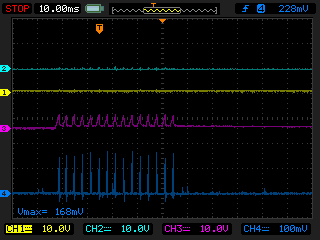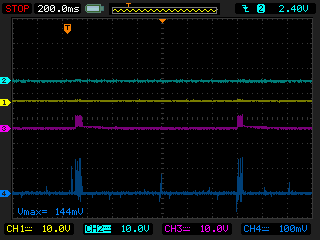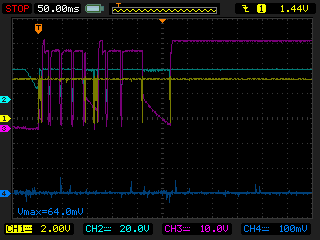Other Parts Discussed in Thread: BQ25750, LM74930, BQ25751
Tool/software:
Good morning everyone,
I am currently experiencing a strange problem while testing out a BQ25751EVM, and would like some suggestions on how to fix the behavior. Please let me know if you require any additional measurements, or information about the test setup.
The problem is as follows:
- The board is able to charge the battery as well as supply power to a load from a power supply connected to VAC (J1 on the board).
- If the power supply at VAC is off, then current will flow from the battery to the load on VSYS via BATFET (Q7,Q8), provided the load is connected after BATFET becomes active.
- However, if the battery and load are being charged from VAC, and the power from VAC is either turned off or disconnected, the system will end up in an invalid state. The system will repeatedly pulse BATFET for 10 cycles, then turn off entirely for a full second before trying again.
- Reconnecting VAC if the board is in this state does not result in the board resuming it's initial state. The only way to return to a regular state is to disconnect and then reconnect the load.
Below is the waveforms of the behavior: Channel 4 is connected to a current clamp that is monitoring the current flowing out of the battery. It's sensitivity is 10mV/A. Channel 3 is connected to BATDRV, Channel 2 is VAC, and Channel 1 is connected to the output.
The first waveforms are of the periodic current spikes observed. If the readings on channel 4 are to be believed, these spikes are up to 16A in magnitude.

The exact spacing between pulses is 3.2ms.

Conditions needed to reproduce the behavior:
You must have a load connected to VAC that is consuming more than some amount of current. The amount of current draw required to reproduce the error is inconsistent and can change. However the lowest I have seen this current value is 270mA, and the highest I have seen is 3.8A. The behavior starts once the load is either disconnected or unplugged.
Test Setup Details:
There have been several modifications made to the eval board so that it matches with the design of a circuit we are validating. These are summarized in the table below:
|
Designator |
Function |
Old Component |
New Component |
Footprint |
|
R34 |
Expand Temp Range |
5.23kΩ |
6.49kΩ |
0603 |
|
R65 |
Expand Temp Range |
30.1kΩ |
20kΩ |
0603 |
|
R67 |
ICHG |
4.99kΩ |
13.8kΩ |
0603 |
|
R66 |
ILIM_HIZ |
2.49kΩ |
2kΩ |
0603 |
|
R21 |
ACUV |
1MΩ |
0Ω |
0805 |
|
R27 |
OV/UV prot |
|
DNP |
0805 |
|
R30 |
ACOV |
25.2kΩ |
0Ω |
0805 |
|
R28 |
Set FB for 24V system |
249kΩ |
100kΩ |
0805 |
|
R64 |
Set FB for 24V system |
13.7kΩ |
6.8kΩ |
0805 |
|
R2 |
AC Current Sense |
2mΩ |
1mΩ |
2512 |
- The load being used on VSYS is a Korad KEL103 electronic load. The test conditions were repeated using resistors instead of the electronic load, and no effect was had on the behavior of the device.
- Switching Power is being provided from an external 5V power supply. It can also be tied to VREG, as this has no effect on the behavior.
- JP1, JP4, JP5, JP6, JP9,JP10, JP12 (2-3), JP13,JP14,JP15, and JP16 are all bridged
- The power supply voltage on VAC is 25V.
- A 24V Sealed lead acid battery is connected to V_out
Additional Information I have Gathered:
- Measuring the gate of all the buck-boost converter's switching elements (HIDRV1,HIDRV2,LODRV1,LODRV2) shows that they all remain at 0 volts when the board is in it's invalid state.
- Reading the fault status and fault flag registers when the board is in it's error state shows no faults
- Reverse mode and auto-reverse mode still behave as expected, the only problem is with the BATFET activation
- Providing switching power from either an external source or VREG has no effect on the behavior observed.


